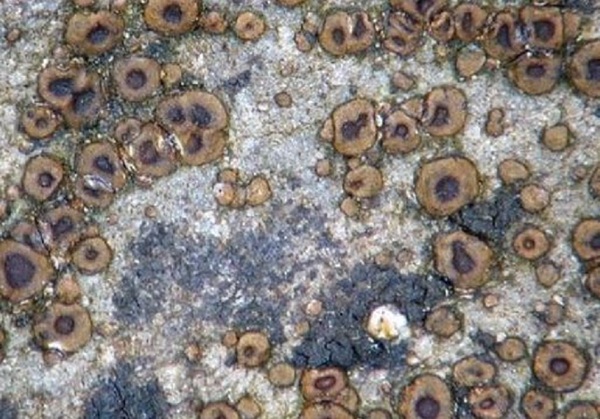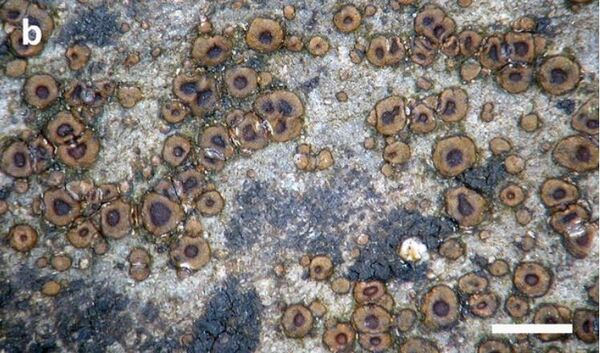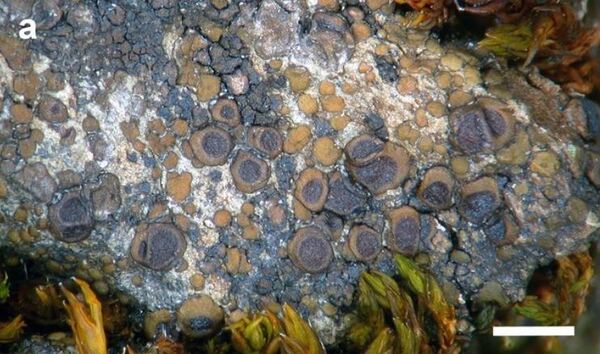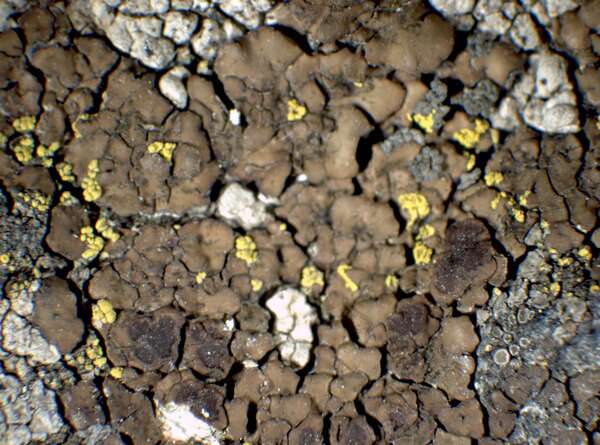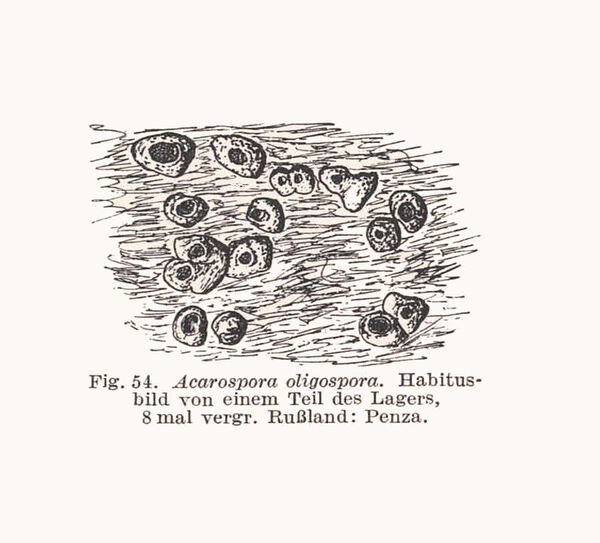Acarospora oligospora (Nyl.) Arnold
Flora, 53: 469, 1870. Basionym: Lecanora oligospora Nyl. - Bot. Not.: 162, 1853.
Synonyms: Acarospora glebosa (Flot.) Körb.
Distribution: N - VG (Castello 2002, Martellos & Castello 2004), Ven, TAA, Lomb, Piem (Isocrono & Ferrarese 2008), Emil (Fariselli & al. 2020). C - Tosc. S - Camp (Aprile & al. 2002), Bas (Nimis & Tretiach 1999).
Description: Thallus crustose, episubstratic, areolate-verrucose, attached by rhizohyphae, forming small, up to 2 cm wide patches. Areoles flat to usually convex, 0.3-1.5 mm wide, 0.3-0.5 mm thick, dispersed or in small groups, olive-brown to dark brown, dull, smooth, epruinose or faintly pruinose, lower surface narrow, subcorticate, pale green from algal layer or pale brown. Cortex paraplectenchymatous, 10-15(-40) µm thick, the upper part brown, the lower part colourless; algal layer continuous, filling most of the areoles; medulla prosoplectenchymatous, white, varying in thickness and usually reduced, continuous with the rhizohyphae. Apothecia one per areole, regularly round, 0.3-1 µm across, with a dark brown to brown-black (reddish when wet) disc and a usually evident thalline margin. Proper exciple thin, forming below the hymenium an up to 20 µm thick, compact, colourless or pale yellowish, prosoplectenchymatous layer with small, rounded to elongated cells; epithecium reddish brown; hymenium colourless, (80-)100-120(-150) µm high, the hymenial gel euamyloid, IKI+ persistently dark blue; paraphyses (1-)1.5-2 µm thick at base, the apical cells barely expanded; subhymenium colourless and 15-20 µm thick; hypothecium indistinct. Asci (16-)24-32(-64)-spored, clavate, the apical dome K/I-, 66-80 x 20-23 µm. Ascospores 1-celled, hyaline, ellipsoid, 9-13(-16) x (5-)6-9 µm. Photobiont chlorococcoid. Spot tests: K-, C-, KC-, P-, UV-. Chemistry: without lichen substances.Note: a holarctic-temperate species found on basic siliceous rocks (e.g. calciferous sandstone and schist), usually on pebbles, but also on walls, roofing tiles, etc., below the subalpine belt; probably overlooked in Italy, but certainly not common.
Growth form: Crustose
Substrata: rocks
Photobiont: green algae other than Trentepohlia
Reproductive strategy: mainly sexual
Pioneer species
Commonnes-rarity: (info)
Alpine belt: absent
Subalpine belt: absent
Oromediterranean belt: absent
Montane belt: extremely rare
Submediterranean belt: very rare
Padanian area: extremely rare
Humid submediterranean belt: very rare
Humid mediterranean belt: very rare
Dry mediterranean belt: absent

Predictive model
Herbarium samples
Growth form: Crustose
Substrata: rocks
Photobiont: green algae other than Trentepohlia
Reproductive strategy: mainly sexual
Pioneer species
Commonnes-rarity: (info)
Alpine belt: absent
Subalpine belt: absent
Oromediterranean belt: absent
Montane belt: extremely rare
Submediterranean belt: very rare
Padanian area: extremely rare
Humid submediterranean belt: very rare
Humid mediterranean belt: very rare
Dry mediterranean belt: absent

Predictive model
| Herbarium samples |
 INDEX FUNGORUM
INDEX FUNGORUM
 GBIF
GBIF
 DOLICHENS
DOLICHENS
